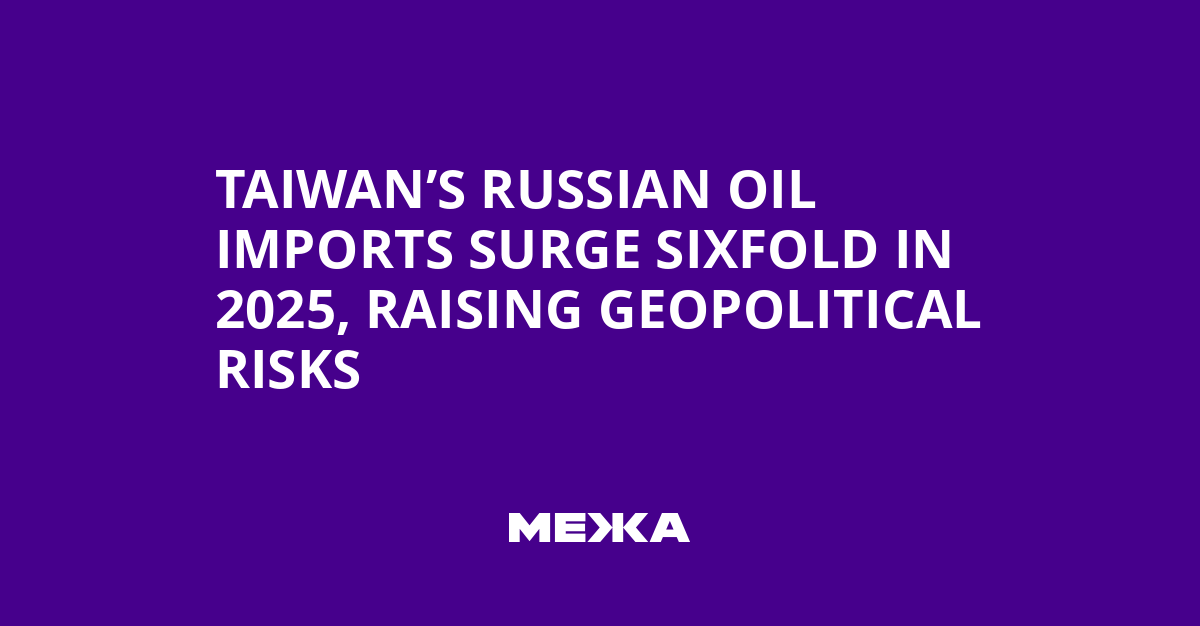Imports of Russian oil to Taiwan have grown nearly sixfold since 2022. According to experts, this import brought Russia around $1.7 billion in revenue from the mineral extraction tax, which could be enough to finance about 170,000 Gerbera-type drones.
According to independent think tanks, average monthly supplies of Russian oil to Taiwan have risen almost sixfold versus the 2022 average and the first half of 2025. Such pace underscores Taiwan’s growing dependence on imported fuel from Russia.
Experts warn that excessive dependence on Russian oil creates energy-security risks for the island and also heightens diplomatic and economic tensions with countries imposing sanctions on the Russian Federation, as well as potential secondary measures or manipulations by Russia and its allies.
Although Taiwan has provided Ukraine with roughly $50 million in aid since the start of the full-scale invasion, imports of Russian fuel during that period amounted to $11.2 billion – significantly exceeding the size of humanitarian assistance.
Since the start of Russia’s full-scale invasion through the end of June 2025, Taiwan imported 6.8 million tonnes of Russian oil worth $4.9 billion, accounting for about 20% of Russia’s total exports; Taiwan has joined the top three largest buyers of Russian oil in the world.
Taiwan’s Import of Russian Oil: Scale and Implications
From the start of the war through June 2025, Taiwan imported 6.8 million tonnes of Russian oil worth about $4.9 billion, making it one of the world’s top three importers of this commodity.
The largest volume of shipments was provided by the FPCC Formosa Petrochemical Corporation refinery, which received about 96% of the total volume of Russian oil to Taiwan, while the share of dependency rose from around 9% at the start of 2025 to about 90% in the first half of 2025.
The EU, the United States, and the United Kingdom imported petrochemical products made from Russian oil at FPCC, totaling about $334 million; these shipments are likely to contain Russian molecules due to the high dependence of production on fuel from Russia.
On September 16, 2025 Taiwan imported gasoil worth $43.8 million from a tanker carrying fuel from the Vadinar refinery in India; such purchases create secondary sanctions risks and undermine Western partners’ measures.
Since the start of the full-scale invasion FPCC remained the largest known buyer of Russian oil in the world. Approximately 88% of Russia’s oil imports to Taiwan were transported by ships affiliated with a coalition of price-imposing countries; prices have exceeded the $45 per barrel limit since December 2023, signaling a breach of policy.
The Novatek company, which is under U.S. sanctions, supplied about 72% of Taiwan’s imports of Russian oil. Continued procurement could strain Taiwan’s diplomatic relations with the United States, the EU, and other strategic partners, while creating payment risks under international sanctions and possible energy pressure from Russia.
In September 2025 the European Commission noted that in the 19th package of anti-Russian sanctions there are no plans to stop oil supplies via the Druzhba pipeline. Later, during a speech at the United Nations General Assembly, the U.S. president again emphasized that NATO member states should review their energy dependencies on the Russian Federation. It was also reported that Hungary and Slovakia import oil from Russia via the Druzhba pipeline at more than 200–250 thousand barrels per day, which accounts for about 3% of the EU’s demand for this commodity.
In sum, the data indicate significant economic and geopolitical risks for Taiwan and stress the importance of a balanced approach to energy supplies and partnerships with the United States, the EU, and other global players to reduce dependence on Russian oil and strengthen supply stability.
